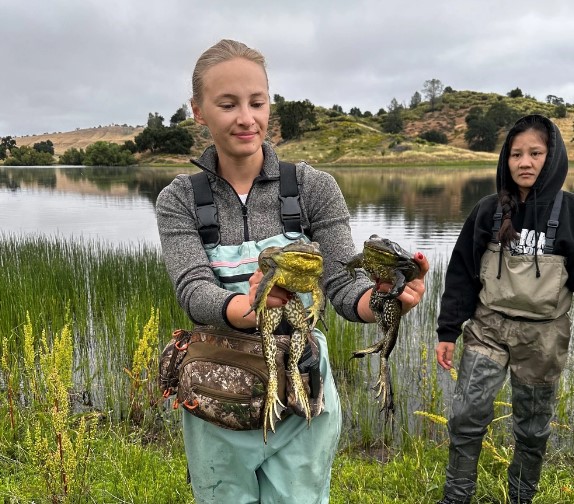Conservation efforts at Fort Hunter Liggett enhance habitat for endangered toad

Center for Environmental Management of Military Lands biologists work day and night to combat the American Bullfrog invasive species at Fort Hunter Liggett. These bullfrogs are found in almost every waterway and pond at Fort Hunter Liggett. Courtesy photo.
– Earth Day is a chance to showcase the Army’s environmental stewardship in places such as Fort Hunter Liggett (FHL), the largest Army Reserve installation, which is a gem not only for military training but also for its expansive habitat for wildlife and natural resources. The remoteness and diversity of the landscapes at FHL support a variety of plants and animals while providing varied terrains for a realistic military training environment.
“It is a blessing to work in this beautiful environment,” said Garrison Commander Col. Stephen Trotter. “It may seem like an oxymoron for some that the military actually plays a huge role in protecting threatened and endangered species, but we actually have a significant environmental program with staff working closely with military trainers to avoid historical, cultural and protected areas.”
The FHL Public Works Environmental Division partners with California Conservation Corps through an Intergovernmental Support Agreement that outlines a 10-year plan to remove the invasive salt cedar (Tamarix parvilflora) to improve the San Antonio River habitat for the endangered arroyo toad (Anaxyrus Californicus). Each year, the corps will remove a section of plants by hand and then chip the material outside of the active flood zone. Herbicide is applied directly to the cut stumps to prevent resprout.
The corps’ Los Padres Santa Maria crew of eight began this project in August of 2023 and will return later this year to continue efforts.
“We set up a spike camp in which we lived, camped in tents, and cooked all our meals for eight straight days,” said California Conservation Corps Project Coordinator Ben Herbert, “It was a special experience because it gave us a chance to work in areas civilians usually don’t get to see.” The corps also used the chance to explain its mission and learn about FHL’s environmental mission.
The FHL Environmental Division evaluates the success of the project by conducting plant and stream channel surveys. The removal of invasive plants also promotes the growth of native species and a drought-tolerant environment.
The arroyo toad was listed as endangered on Dec. 16, 1994. According to the U.S. Fish & Wildlife Service, it can only be found along the central and southern coast of California to the northwest of Baja California, Mexico. The species faces a variety of threats to its survival, reproduction, and persistence. These threats include non-native predators and plants, disease, water withdrawals, agricultural and urban development, pollution, and natural disturbances (e.g., drought and climate change).
“The arroyo toad population at Fort Hunter Liggett is struggling because the natural vegetation is choking out prime breeding habitat for the species,” said Jackie Hancock, the FHL Environmental Division project lead. “The salt cedar exacerbates the problem because its massive root balls hold on to the sediment which alters the stream channel morphology unfavorably. It also draws a lot more water from the ground than the native plants, changing the hydrology around dense stands.”
Hancock adds that she’s excited to see the plan that has been in the works for many years finally put into action. “It will take several years to eradicate the salt cedar, but I’m optimistic that we’ll get there,” said Hancock.
“We rely on IGSAs and cooperative agreements to assist with our natural resources program. Managing 12 threatened and endangered species and implementing our Integrated Natural Resources Management Plan is a huge undertaking!” said Public Works Environmental Chief Liz Clark.
The environmental division has an integrated natural resource management plan that provides the framework for meeting the Army’s goal to systematically conserve biological diversity under the principles of ecosystem management.
“Intergovernmental support agreements help us meet our mission requirements and save the Army money,” said FHL Support Agreements Specialist Brian Lucid, “We estimate the agreement with California Conservation Corps saves us $10,000 per year compared to a commercial contract for the same service.”
Army installations host some of the most diverse and unique plant and wildlife communities in the nation and maintain millions of acres of healthy forests through partnering with federal and state foresters to apply best management practices. To learn more about how the Army protects, preserves, conserves, and restores natural and cultural resources, visit https://aec.army.mil.





















